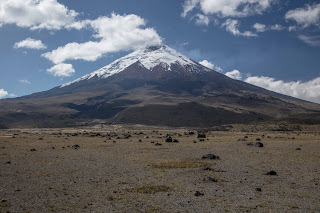The Galapagos. It was a tricky decision to go, it's a very expensive place to visit with limited access and indeed options, but it does still have some exotic and incedible wildlife and we were going to be in Ecuador anyway, so...
We booked our voyage through our birding lodge agent in Ecuador and joined the Infinity having landed at Santa Cruz.
The first stop was a dingy ride into a mangrove lagoon to watch breeding sea turtles (early) and spot some of the more obvious birds such as this Brown Pelican:
And a Blue-footed Booby just taking off:
That evening and night we motored Northeast to Genovesa, an island just North of the Equator. It's fair to say we didn't adapt to either the motion of the ocean or the noise of being on a smallish metal boat.
The following morning we visited the first landing site, seeing our first Nazca Booby:
A Lava Gull, one of perhaps 500 individuals left on the planet, alighted on the boat before we landed ashore:
We also saw another scarce and endemic species, the Swallow-tailed Gull:
And the iconic Marine Iguana:
As the top predator on the Island, the Short-eared Owl hunts whenever it wants to, so we got outstanding views of this bird:
A Red-billed Tropicbird settled on the lava:
Beyond Genovesa, which was a real highlight of the trip, we visited Santiago, Santa Cruz again (mostly to pick-up and drop-off some passengers).
One of the main reasons for wanting to visit the Galapagos is their relationship with 'Chuckie D' as Charles Darwin is affectionately called there. Darwin's finches are widely credited with forming an important bedrock of his development of the then theory of evolution and his book On the Origin of Species, by means of Natural Selection. The bill shapes of the species being specifically adapted to habitat and food.
We saw a number of these finches, including the Large Ground Finch:
However it turns out the species classification was undertaken by a colleague of Darwin's in London and it was in fact the speciation of the Mockingbirds, here the Galapagos Mockingbird, that initially drove his thinking:
Seeing these iconic and indeed important species was a particularly rewarding part of the trip for us. Seeing some of the signature species of the Islands was rewarding too, including this species of Giant Tortoise:
There's a huge amount of conservation work ongoing across the archipeligo, saving these species is one of the more visible projects ongoing.
At Sullivan Bay, we saw Red-footed Boobies, both the common brown morph:
And the 1 in 20 white morph:
In the second half of the voyage we stopped at Rabida, an island with a lot of recent lava flows, the view here looking out to a collapsed caldera from the 100-year old lava field, with Infinity anchored in the channel:
The lava moved slowly forming air bubbles that collapsed over time:
We joined various walks, taking in the unique landscape, here sea coral sand between the emerging vegetation and the lava:
Spotting some of the Caribbean Flamingo that inhabit the islands:
One particularly interesting stop on Santa Cruz was specifically to see the land Iguana, this dry forest being their key habitat:
You can see why they are so iconic and indeed popular with visitors:
We got a call across the tannoy at one point while motoring, dolphins had been spotted, luckily my camera had been set for in-flight photography so i was ready to go when these two Bottlenose Dolphins breached:
Almost every beach had breeding Sealions, with lots of pups between hours and weeks old:
Blue-footed Boobies were relatively common too, this one had glowingly blue feet:
The last major stop and another highlight for us was Espanola Island, which hosts the subspecies of Marina Iguana know locally as the Christmas Iguana for the red skin tones taken from their algae diet:
More young sealion pups:
Lava Lizards:
And my target species for the entire trip, the Waved Albatross:
We even got to witness their mating behaviours, properly magical if also sad as this is way too late in the season, behaviours driven by climate change:
More Nazca Boobies, with different bill and eye colours showing their respective ages:
The iguanas seemed to be hugging, though in reality probably too lazy to move while warming their bodies under the equatorial sun:
Our very last stop on Espanola island was a beach drop, you get dropped on the beach and can walk, swim, sunbathe. It was overcast and breezy and the water was cold but Helen took the opportunity to get her Galapagos swim fix before we got back on board and motored for San Cristobal and our departure the following day:
San Cristobal included a visit to an interpretation centre before 90 minutes of free time and then the bus to the airport. We chose instead to walk a short trail beyond the centre taking in a viewpoint and harbour point and then walking back into the town. We saw a few of the local species including at least one last lifer, although having been assured the San Cristobal Mockingbird was only visible in the forest, they were in fact spotted in the shrubbery in the town, while we drank a pleasant coffee.
It's fair to say we found a week on a smallish and ferociosuly expensive boat quite challenging, but it is by far the best way to make the most of the Galapagos,
Next up then a cultural and scenery tour en route to Quito...
































































